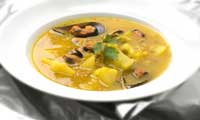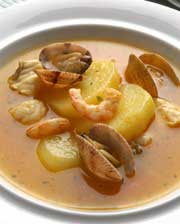Suquet
Origin: Catalonia
Suquet is a dish from Catalonia in the North-East of Spain which is a delicious fish stew. However depending on who cooks the suquet, depends on whether you would call it a stew or a soup, depending on the amount of liquid used. Either way, Suquet is definitely worth trying, whether that be in a Spanish restaurant when you visit Barcelona, or in your own kitchen if you follow our recipe below.

Spain is well known for its fish and seafood, an industry which is particularly important to the Spanish economy, particularly in the regions of Catalonia and Valencia. These are the two main regions where you will find this seafood stew. A clue to this is in the name which comes from the Catalan language. Suquet is a form of the word 'suc' which means juice in Catalan, hence this Spanish dish is known as being a wonderful, juicy fish stew.
When cooking with shell fish it is always a good idea to follow some simple cooking rules becuase it is very easy to get ill from uncooked or bad shell food. Therefore make sure that before you start cooking the clams and mussels are all closed and you should remove any of the shell fish whose shells are already open. You should only cook seafood whose shells are closed. However, after cooking the seafood, look out for any of the mussels or clams whose shells are still closed. Closed shells after cooking also means that they are unedible and that you should get rid of them.
These simple rules will, hopefully, avoid any upset stomachs. An allergy to seafood is quite a widespread issue so if you are thinking of cooking this dish for somebody else, it would be wise to find out whether any of your guests are allergic to seafood.
Suquet | Spanish Seafood Stew
Ingredients:

- 12 Manila / small littleneck / cherrystone clams
- 1 tbsp coarse salt
- ½ cup Olive oil
- 2 cloves of garlic, whole, peeled
- 8 blanched almonds
- 1 tbsp fresh parsley, chopped
- 1 tbsp water
- 1 yellow onion, chopped finely
- 1 tomato, skin removed, halved and grated through large holes of a grater
- Pinch of saffron
- 6 cups of fish stock
- 2 lbs monkfish fillet, cut into small pieces
- 1 lb hake fillet, cut into small pieces
- 1 lb squid, cleaned and cut into thin rings
- 6 large shrimps, complete and in shell
- 12 medium sized shrimps, peeled
- ½ lb mussels, scrubbed and debearded
- ½ cup of cava or sparkling white wine
- Serves 6
Preparation:
- Scrub the clams under cold water and throw away any that are open. Then, put the clams and the coarse salt into a bowl and cover them with water. Allow to stand for at least 30 minutes and up to around 2 hours so that any excess sand is released.
- In a large, deep pan, heat up the olive oil over a large flame. Then add the garlic and fry for around 1 minute or until the garlic is golden in colour, stirring constantly. Transfer the garlic to a mortar using a slotted spoon so as to drain the excess oil. Take the pan off the heat but keep the oil in it.
- To the mortar, also add the almonds, water and parsley and grind with the pestle until you make a paste. Leave this to one side.
- Put the pan of oil back on to a medium heat. Add then onion to the pan and sauté for 5 minutes or until the onion is soft.
- Add the tomato and saffron to the onion in the pan and cook for another 5 minutes, mixing well, allowing the flavours to combine.
- Meanwhile, bring the fish stock to the boil in a separate pan and then reduce the heat but keep the stock at a simmer.
- Add the monkfish, hake, medium and large shrimp to the pot of onions and tomatoes and mix well. Then add the almond, garlic and parsley paste and mix well. Stir in 1 cup of the hot fish stock to the pan and cook for around 30 minutes. Every 5 minutes, add a further cup of stock to the pan. After 30 mins, the fish will be cooked through and all the flavours will have combined.
- Season the broth to taste with salt. Drain the clams from their salt water and then add them to the pan along with the mussels, making sure that you get rid of any of the shellfish which is already open. Also add the cava to the pan.
- Mix well and then serve the stew.


